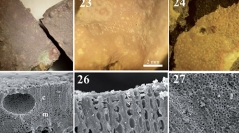

 Cryptogamie, Algologie
36 (4) - Pages 429-459
Cryptogamie, Algologie
36 (4) - Pages 429-459Phymatolithon lusitanicum is a new maerl species described based on an integrative systematic approach including molecular (COI-5P, psbA) and morphological data obtained from recent collections, as well as comparison of type material from the morphologically and ecologically alike NE Atlantic species P. lamii and P. laevigatum. Molecular analyses including type material of P. lamii and P. laevigatum were congruent in delimiting P. lusitanicum as an independent lineage from these crustose species. The three species shared a common external morphology of multiporate asexual conceptacles, but P. lusitanicum has been detected only unattached as maerl while P. lamii and P. laevigatum are crustose. Phymatolithon lusitanicum is particularly abundant in subtidal maerl beds of the Atlantic Iberian Peninsula (Galicia and the Algarve); however it has also been detected northwards in Ireland intertidally and in Western Mediterranean Sea (Alborán Sea, Balearic Islands) down to 64 m. Phymatolithon lusitanicum differs from other Phymatolithon species reported for the European coasts mainly by the external shape of the multiporate asexual conceptacles (pore plate flush with surface or slightly sunken without a conspicuous thick raised rim) and its unattached habit as maerl/rhodolith. In addition, the lectotype of Lithothamnion hamelii turned out to be conspecific to Phymatolithon calcareum, therefore this taxon is proposed as a heterotypic synonym of P. calcareum. Finally, our molecular analyses detected cryptic diversity within the European collections of Phymatolithon, while collections identified as P. lenormandii from Canada or P. repandum from New Zealand were resolved as unrelated to the remaining Phymatolithon. In the light of these results, it is clear that further work is necessary to resolve species diversity within the genus Phymatolithon and its relationship with related genera.